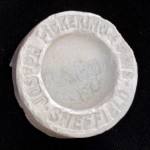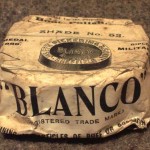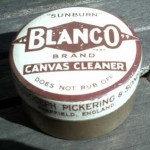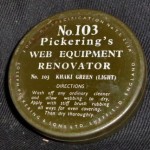Potted history of web cleaning
Since the at least the late 1700’s the British Army had been whitening belts and other personal equipment. For this, they used a preparation made from pipe-clay – a very white clay when fired and ground down. Pipe-clay was plentiful around the country and was exploited extensively for making pottery as well as clay pipes. As such, a very cheap and workaday compound. And as with many nouns, it became transformed into a verb – to pipe-clay leather.
 Joseph Pickering & Sons were a company that produced polishing compounds and rouges for the cutlery trade of their home city of Sheffield and beyond. Grinding minerals to powders of various grades and supplying them as powders or cakes was their stock in trade. John Needham Pickering, a Volunteer (predecessor of the Territorial) thought his family firm could produce something better than the traditional pipeclay for whitening the Slade Wallace buckskin equipment the Army then wore. They developed a pure white compressed block product that could, by the addition of a little water, be applied with a sponge, rag or brush. They sold it to the local Hillsborough barracks who adopted his product and their extra white webbing was admired and led to it’s adoption by the rest of the army from about 1880.
Joseph Pickering & Sons were a company that produced polishing compounds and rouges for the cutlery trade of their home city of Sheffield and beyond. Grinding minerals to powders of various grades and supplying them as powders or cakes was their stock in trade. John Needham Pickering, a Volunteer (predecessor of the Territorial) thought his family firm could produce something better than the traditional pipeclay for whitening the Slade Wallace buckskin equipment the Army then wore. They developed a pure white compressed block product that could, by the addition of a little water, be applied with a sponge, rag or brush. They sold it to the local Hillsborough barracks who adopted his product and their extra white webbing was admired and led to it’s adoption by the rest of the army from about 1880.
 Prior to the turn of the century the army where revising their uniform requirements, adopting a much less visible look by the universal adoption of the colour khaki. From this point, the soldier’s leather equipment was coloured khaki, not white. Pickerings weren’t slow to spot a potential market and capitalised on the white product they already sold to the military by simply adding pigments the Blanco base product to make coloured versions. They had original white Blanco (product code 100 for mould only, 101 for mould in tin, 102 for mould in box with sponge), Khaki-Blanco (product code 103 as refill moulds – 104 when supplied in tin, but seemingly re-named No 64 at some point) which was a close colour match to raw webbing and introduced in 1900. This was approved by the authorities and the word ‘Blanco’ became firmly entrenched in the day to day lives of the British soldier. Yet another noun was turned into a verb as Tommys busily blancoed their webbing.
Prior to the turn of the century the army where revising their uniform requirements, adopting a much less visible look by the universal adoption of the colour khaki. From this point, the soldier’s leather equipment was coloured khaki, not white. Pickerings weren’t slow to spot a potential market and capitalised on the white product they already sold to the military by simply adding pigments the Blanco base product to make coloured versions. They had original white Blanco (product code 100 for mould only, 101 for mould in tin, 102 for mould in box with sponge), Khaki-Blanco (product code 103 as refill moulds – 104 when supplied in tin, but seemingly re-named No 64 at some point) which was a close colour match to raw webbing and introduced in 1900. This was approved by the authorities and the word ‘Blanco’ became firmly entrenched in the day to day lives of the British soldier. Yet another noun was turned into a verb as Tommys busily blancoed their webbing.
 Towards the end of the 19th Century the Mills Equipment Company developed the P08 webbing and in 1910 adopted a patented web cleaner (a soluble product based on pigment with soap and potash alum added) as their official web cleaner. It was a powder product supplied in sprinkle drums which was mixed to a creamy consistency and applied to the cotton webbing equipment. This gave a completely consistent colour to used and soiled webbing and enhanced the smartness by which the Army held great store. It was of somewhat greener hue than natural webbing. Pickerings added a green-hued colour to their range as well – Web-Blanco. WWI web equipment then was either coloured something like natural webbing or a dull pale green.
Towards the end of the 19th Century the Mills Equipment Company developed the P08 webbing and in 1910 adopted a patented web cleaner (a soluble product based on pigment with soap and potash alum added) as their official web cleaner. It was a powder product supplied in sprinkle drums which was mixed to a creamy consistency and applied to the cotton webbing equipment. This gave a completely consistent colour to used and soiled webbing and enhanced the smartness by which the Army held great store. It was of somewhat greener hue than natural webbing. Pickerings added a green-hued colour to their range as well – Web-Blanco. WWI web equipment then was either coloured something like natural webbing or a dull pale green.
 And so Pickerings continued to sell to the forces during the interwar period and boosted sales with both additional and repackaged products destined for a domestic market for cleaning canvas tents and such goods. Strictly speaking, of course, the web cleaning products don’t clean at all – you have to do that yourself prior to product application, but the end result is certainly an item that looks fresh, uniform in colour and clean! Not that Pickerings had the market entirely to themselves. Since the turn of the century, many companies made white compressed block products similar to white Blanco but companies like Propert made jars of liquid webbing renovators in many colours including green and khaki (equivalent to Pickering’s 97 and 103) and Cherry Blossom’s Kharkene.
And so Pickerings continued to sell to the forces during the interwar period and boosted sales with both additional and repackaged products destined for a domestic market for cleaning canvas tents and such goods. Strictly speaking, of course, the web cleaning products don’t clean at all – you have to do that yourself prior to product application, but the end result is certainly an item that looks fresh, uniform in colour and clean! Not that Pickerings had the market entirely to themselves. Since the turn of the century, many companies made white compressed block products similar to white Blanco but companies like Propert made jars of liquid webbing renovators in many colours including green and khaki (equivalent to Pickering’s 97 and 103) and Cherry Blossom’s Kharkene.
 At the start of WWII both Web-Blanco and Khaki-Blanco were in use – reenactor folklore has it that the so-called ‘Pea green’ No. 97 (more like the colour of dried peas than fresh peas!) saw overseas use by the BEF. From at least as early as August 1943 a new colour (new or reintroduced since there was an old shade called 53 which is a dead ringer for KG3) became the official standard – Khaki Green No. 3 and Meltonian, Pickerings, Chiswicks, Properts and Hamiltons/Mills brands were approved. Possibly the nomenclature was derived from the Standard Camouflage Colour chart where colour number 3 was called Khaki Green. This saw universal use come the D-Day invasion and the start of the European campaign. Also introduced, probably prior to WW2, were 61 Buff and RAF Blue Grey (there is reference to a renovator for the RAF’s webbing introduced many years before the war but no evidence of its existence has yet come light other than that produced after the war).
At the start of WWII both Web-Blanco and Khaki-Blanco were in use – reenactor folklore has it that the so-called ‘Pea green’ No. 97 (more like the colour of dried peas than fresh peas!) saw overseas use by the BEF. From at least as early as August 1943 a new colour (new or reintroduced since there was an old shade called 53 which is a dead ringer for KG3) became the official standard – Khaki Green No. 3 and Meltonian, Pickerings, Chiswicks, Properts and Hamiltons/Mills brands were approved. Possibly the nomenclature was derived from the Standard Camouflage Colour chart where colour number 3 was called Khaki Green. This saw universal use come the D-Day invasion and the start of the European campaign. Also introduced, probably prior to WW2, were 61 Buff and RAF Blue Grey (there is reference to a renovator for the RAF’s webbing introduced many years before the war but no evidence of its existence has yet come light other than that produced after the war).
Then there was something of a rationalisation of naming (date unknown and may well have been post-WWII) and ‘Web-Blanco’ became renamed as 97 Khaki Green (Medium), ‘Khaki-Blanco’ became 103 Khaki Green (Light) and Khaki Green No. 3 became KG3 Khaki Green (Dark).
Some 30 million blocks of Blanco were supplied during WW2 which works out at less than two blocks a year per soldier which suggests that servicemen spent less time cleaning their webbing than popularly supposed!
 Post-WWII Pickerings found their product use rapidly declining with demobilisation and then the late 1950’s gradual adoption of pre-dyed webbing but they still had a market that they tried to maintain. As web cleaning use rapidly declined KG3 was supplied in utilitarian unbranded packaging. Then in 1951 and 1952, a new utilitarian packaged product was introduced that wasn’t a round compressed powder block of the last 75 years but was a solid denser waxy compound. Given exactly the same stores code as its predecessor, this was an experimental product issued in trials worldwide in an effort to find an easier and cleaner working product that had waterproofing qualities as well and smartening and colouring.
Post-WWII Pickerings found their product use rapidly declining with demobilisation and then the late 1950’s gradual adoption of pre-dyed webbing but they still had a market that they tried to maintain. As web cleaning use rapidly declined KG3 was supplied in utilitarian unbranded packaging. Then in 1951 and 1952, a new utilitarian packaged product was introduced that wasn’t a round compressed powder block of the last 75 years but was a solid denser waxy compound. Given exactly the same stores code as its predecessor, this was an experimental product issued in trials worldwide in an effort to find an easier and cleaner working product that had waterproofing qualities as well and smartening and colouring.
Following these trials, in which the Army sought to find a more practical solution to webbing cleaning, a new product was launched in 1954. Supplied by Pickering it was sold exclusively through the NAAFI. It could be used on self-coloured & waterproofed ’44 pattern webbing as well as ’37 and made application with a brush clean and easy. Equipment could be kept smart by touching up.
Come the 60’s and 70’s competitor products arrive, some like Propert’s which was approved, others unapproved. Still, there are recollections of even in the late 1980’s of soldiers, sailors and airmen on basic training blancoing away on their issued ’37 pattern webbing and mention the word Blanco to those who did National Service and you will be met with a gritting of teeth and a rolling of eyes!
Pickerings the company abandoned it’s powder products – the Sheffield cutlery trade having vanished overseas and the military trade being lost to new equipment innovations but they still continued with the packaging side of the business they had always been involved with, formerly with zinc lined tins that contained the Blanco product but latterly with box packaging. The company sadly closed in 2009 after 185 years in business and with it went the last tangible link to Blanco. Pickerings were there at the start of the pre-manufactured web cleaning compound era and there at the end. A more basic and utilitarian product it would be hard to find and yet there are still many mysteries yet to be unravelled.
Written by David Pratt
